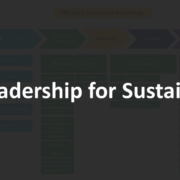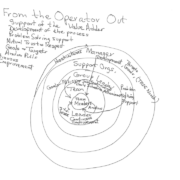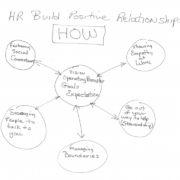The Value of Context and Contextualization
(Reposted by permission of the author from LinkedIn)
It is time that we discuss the key issue of why these articles have been written. The “why” is what we call context and it is invaluable for an understanding of HR. Context is the meaning in the message. For those who experience any action taken to create or support, it is the big point that allows members to determine if the organization is a place deserving of their energy and innovation.
Any workplace has the potential to create peak performance from its members, but most choose to set a path that can be good but seldom great. The difference is not in any tool or mandate; it is in the engagement of all those who are members to be their best, knowing it is supported by the organization. It would be nearly impossible to create every source of support consciously, but it is very straight forward to create the context as the lens through which work is viewed. All decisions whether at the top or the bottom can be effectively reviewed to move the organization forward one decision at a time. All of this is possible only if the right context is set consciously for the entire organization to enact.
From the dictionary, context is defined as the surroundings, circumstances, environment, background or setting that determines, specifies or clarifies the meaning of an organization. I know this is too much to digest so I will clarify it to be “the meaning of an organization”. Good, bad or indifferent, it is the silent force from behind the organization that shapes the actions and activities of all organizations. Something we in HR should pay attention to.
The implications are almost overwhelming for us. It means that almost everything has meaning and the management of it will determine our long-term success or failure. It needs a starting place.
At the heart of every organization is the reason why it exists. We have seen over an over that if the only reason they exist is to make money, the implications for those who make it happen are profound and mostly not positive. We have recently seen in the aerospace world that if you only set out to meet a number in cost, the unintended consequence is lives are lost. So we have to go where the organization has meaning. In other words, what purpose is it to serve society? The most obvious place to find the meaning is not in its mission or vision statement but in its goals and strategies. For the people in the organization, it is the words where they see what is foremost in the minds of the owners and executives. Unfortunately, as important as these are, goals and strategies get interpreted in actions that are left to individual interpretation. This leaves us with a void and a clear mandate to align these goals throughout the organization to its members or leave it up to the interpretation of each individual.
Each individual will have a role to play. If those goals come with a context, the meaning behind them, then roles become easier to align. It’s a powerful force if the individual can not only see the “what” but also the “why” or context. This is the beginning.
All organizations want to achieve peak performance. In peak conditions all the actions are purposeful. All the interactions are affirming. All the deviations are treated as conditions for learning. The organization is doing meaningful work, the people are energized by their assignment and the results are performances that are superior.
To achieve this condition, the individual’s work needs purpose, the methods to match the intent and the level of negative actions, greatly diminished, are easily contained minimizing stress from the equation.
This sounds great, and it can be, but the way it happens is just as important. The change to peak performance is a multi-faceted solution. You are changing not only the “how” but the lens through which work is intentionally viewed. You have prepared the workforce for the change by giving them training and time to experience. You have chosen a workplace that is governed by mutual trust and respect. You have chosen kindness as an intention and you have gone to work to reduce the stressors on the job. In the end, you have created stress-resilient members. In short, you have contextualized the workplace to counter stress and achieve meaning. This makes sense because stress is debilitating to the worker. It takes their energy, initiative and creativity from them causing meaning to be lost.
How does the context get committed to? It principally takes two main initiatives to give peak performance a chance. First, a basis of comparison must be established. It can be a set of standard work or clear expectations backed by metrics. Metrics and the standard practice that supports them should be proactive in nature, easy to understand and implement. Metrics must be infallible so performance can be accurate and reliable. The major value this serves is to allow everyone to visually see and react to deviations from the standard. The reaction must be positive in nature and reinforced by mutual trust and respect from all concerned. Problems become opportunities. Management must be willing to be measured in the manner prescribed. Hiding problems will only exaggerate problems and create stress for all concerned.
This methodology comes from the interaction of several consciously designed features. Relevance is one of them that ensure that all concerned will be willing to engage to achieve peak results. Effectiveness is a second feature that allows relevance to be enacted. All must see the connection between business objectives and performance in features. The features must have transference to not create isolated efficiency. The design must have social consciousness to engage all through a construct of fairness and equity. The skills taught must be interactive to show first the big picture and then the detailed expectations in explicit standards developed by those who use them every day. All must be able to see the nuances of performance to achieve the peak. Assessments of condition must be easily extracted into improvements easily implemented
An important gateway to peak performance is to enact the best relations with employees. Implications for HR requires dedicated thought to contextualize the workplace. HR is trying to make the workplace simple and selective. It works to achieve a shared understanding of targets and goals. The design of tools and interactions is made for relevance, effectiveness and transference, which is designed and implemented with a social conscious. They are designing for optimal interaction creating the big picture first to see nuances.
In the process of doing the design, HR must consider the alignment of the supervision and management, and how to use KPIs to gain focus. KPIs require valid sources of information. HR will adopt a mandate to train before it Is needed while eliminating the information overload to allow focus. This will achieve a centering of the workforce.
The environment to be created sets a connection through empathy and kindness, knowing that people learn better when encouraged to connect with what they see. The results that should be seen are a positive change in attitude which improves with members experiencing quicker decision making around key issues. All of this arises out of clarity of purpose that builds momentum as problems are solved and opportunities are taken.
For members, they will be able to keep the goals in focus by the significant change in relationships. For HR, the baseline is an understanding of where you are and an understanding of where you are going, supported by a clear understanding of what needs to be done. Communications are focused on the difference achieved and their contribution to all. In the end, the organization becomes change resilient with a strong awareness of the current and future situation. The prevailing thinking is “we are in it together” with hope for conscious learning and growing.
Let’s look at a case for contextualization. When I joined Toyota, one of the first things I did was to go to Japan to learn how to build cars. They were not concerned that I could build a car but more about what it felt like to get tired, sore and overwhelmed with the job of a team member. My most vivid recollection was while I was working trying to not miss a step in my 28 step process, wondering if I had what it takes to be a part of Toyota. In the midst of the cycles, an executive from Japan called me off the line and said, “It’s ok to make a mistake” and sent me back to the line. What a relief! When I had time to reflect. I thought, brilliant, he knew exactly what I needed and gave me a gift of understanding that humans make mistakes and we will learn from them. My stress level went way down, and I was able to do my job better.
From that simple experience, probably a planned intervention, I experienced a company taking care of its members by building mutual trust and respect. I felt my silent stress was being heard and that this company knew how to reinforce the right lessons to be learned. It was a conscious decision for context to be contextualized. As I progressed in my understanding of Toyota, I knew those simple acts required planning, interaction with multiple groups, policy to support and a way to support observed best behavior.
For my work in HR, the implications for the future were to create the ability for members to contribute at a peak level, to produce an HR system that will work to create change resilient members, use constant reflection as a tool for creating performance, observation and training in context and measures as a basis of comparison. All of this work created a guiding concept for HR with implications of future value.
Context can be powerful. It will be hard-won and requires exceptional vigilance to sustain. So many of us are focused on creating isolated wins that this truth escapes us. What we have to know is that mutual trust and respect with a clear picture of what is needed for the business and the people is required and is within our grasp. All of this can be achieved by setting the appropriate context for work and the members.

 2019, Total Systems Development, Inc.
2019, Total Systems Development, Inc.
 2019, Total Systems Development, Inc.
2019, Total Systems Development, Inc. 2019, Total Systems Development, Inc.
2019, Total Systems Development, Inc.
 2019, Total Systems Development, Inc.
2019, Total Systems Development, Inc. 2019, Total Systems Development
2019, Total Systems Development 2019, Total Systems Development, Inc.
2019, Total Systems Development, Inc. Total Systems Development, 2019
Total Systems Development, 2019